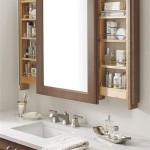How To Install Molding Around Bathroom Mirror
Installing moldings around a bathroom mirror adds an elegant and finished touch to the bathroom decor. It conceals the raw edges of the mirror and provides a decorative frame, enhancing the overall aesthetic appeal of the space. Before embarking on this project, it is essential to understand the different aspects involved in properly installing molding around a bathroom mirror.
Selecting the right molding is crucial. The molding should complement the style of the bathroom and the mirror. Consider the width, profile, and material of the molding. Wider moldings can make a bold statement, while narrower ones provide a more subtle touch. The profile refers to the shape of the molding, and different profiles can create distinct effects. Common materials include wood, MDF, and PVC. Wood moldings offer a classic and natural look, while MDF and PVC moldings are more budget-friendly and moisture-resistant.
Proper preparation is essential before installing the molding. Ensure the mirror is securely mounted on the wall and that the wall surface is clean and free of debris. Measure and cut the molding to the desired length using a miter saw or a miter box. Miter cuts are angled cuts that allow the molding pieces to fit together seamlessly at the corners. Dry-fit the molding around the mirror to ensure a proper fit and make any necessary adjustments.
Applying adhesive to the back of the molding provides a strong and durable bond. Use a construction adhesive specifically designed for mirrors and moldings. Apply the adhesive evenly along the entire length of the molding, ensuring there are no gaps. Carefully position the molding around the mirror and press it firmly into place. Use masking tape to hold the molding in place while the adhesive dries.
Once the adhesive has set, secure the molding further by nailing it into the wall. Use small finishing nails and a nail gun or a hammer and nails. Countersink the nails slightly below the surface of the molding using a nail set. Fill the nail holes with wood filler or spackling paste and allow it to dry.
Finishing touches enhance the overall look of the installed molding. Sand any rough edges or imperfections using fine-grit sandpaper. Apply a primer to the molding to create a smooth surface for painting. Choose a paint color that complements the bathroom decor and apply it evenly using a brush or a roller. Allow the paint to dry completely.
Installing molding around a bathroom mirror is a relatively straightforward task that can add a touch of elegance and sophistication to the space. By following these essential steps and paying attention to the details, you can achieve a professional-looking finish that will enhance the bathroom's aesthetic appeal.

Easy Diy Tutorial Adding Trim Around A Giant Mirror For Ers

Diy Bathroom Mirror Frame With Molding The Happier Homemaker

The Kids Bathroom Mirror Gets Framed House Of Hepworths

How To Frame Out That Builder Basic Bathroom Mirror For 20 Or Less

How To Frame Out That Builder Basic Bathroom Mirror For 20 Or Less

How To Frame A Mirror Sand And Sisal

Diy Bathroom Mirror Frame With Molding The Happier Homemaker

Mirror Molding The Easy Upgrade To Boring Bathrooms Mirrorchic

The Kids Bathroom Mirror Gets Framed House Of Hepworths

Framing A Mirror Without Miter Cuts The Kim Six Fix








